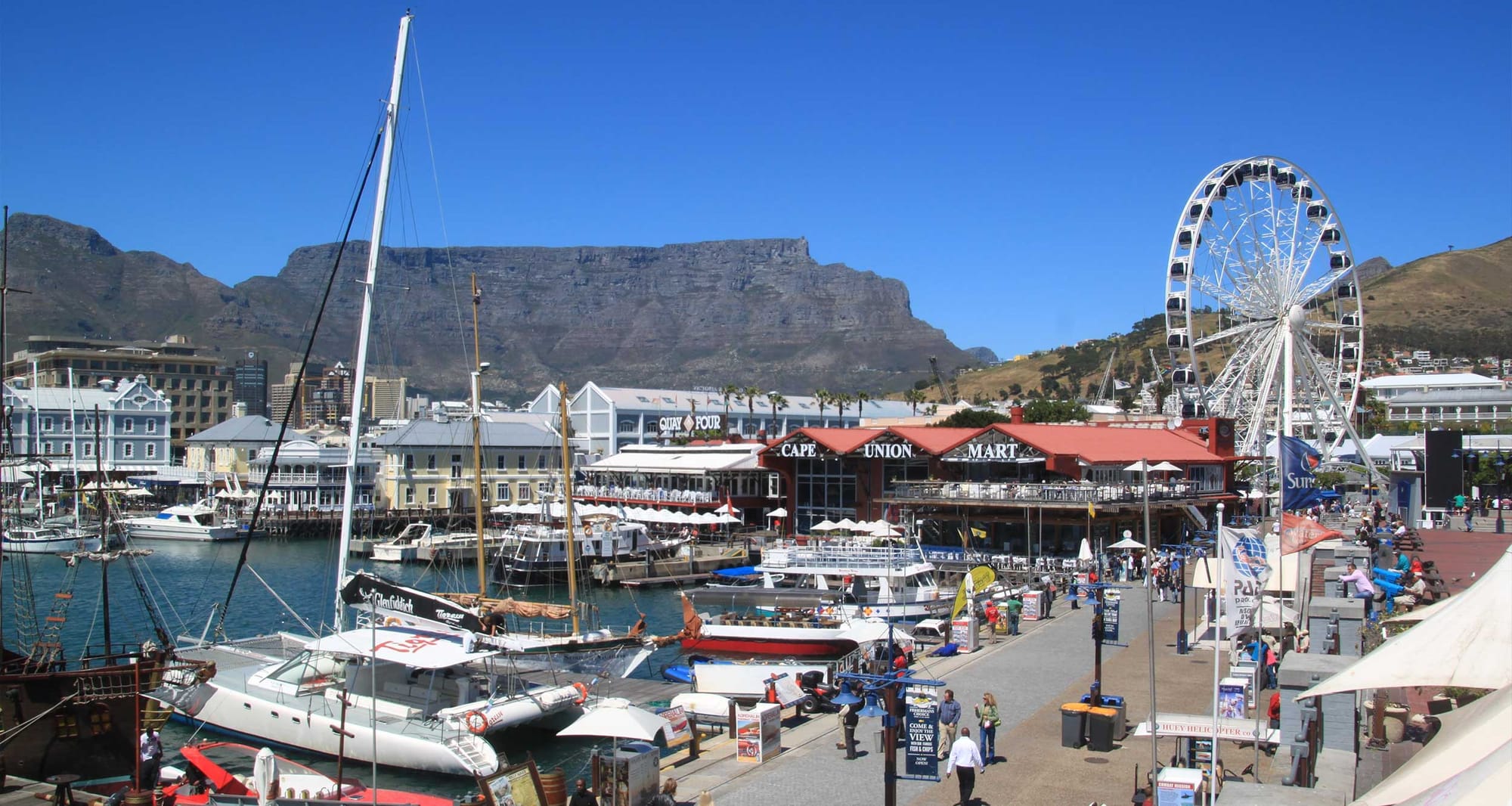
Cape Town is one of the most beautiful cities in the world. Bordering a floral region recognized by UNESCO and set between Table Mountain and the Atlantic Ocean, Cape Town creates a sense of wonder in all who visit. It is a place that travelers can enjoy in all seasons, but offers much more than a favorable climate and natural beauty. The city’s most popular attractions—the cable car to Table Mountain, the tour of Robben Island and the historic V&A Waterfront—are all wheelchair accessible.
Cable Car Ride to Table Mountain
At 3,558 feet tall, Table Mountain dominates the Cape Town skyline. The mountain is part of the Cape Floristic Region, which was designated a UNESCO World Heritage Site in 2004.
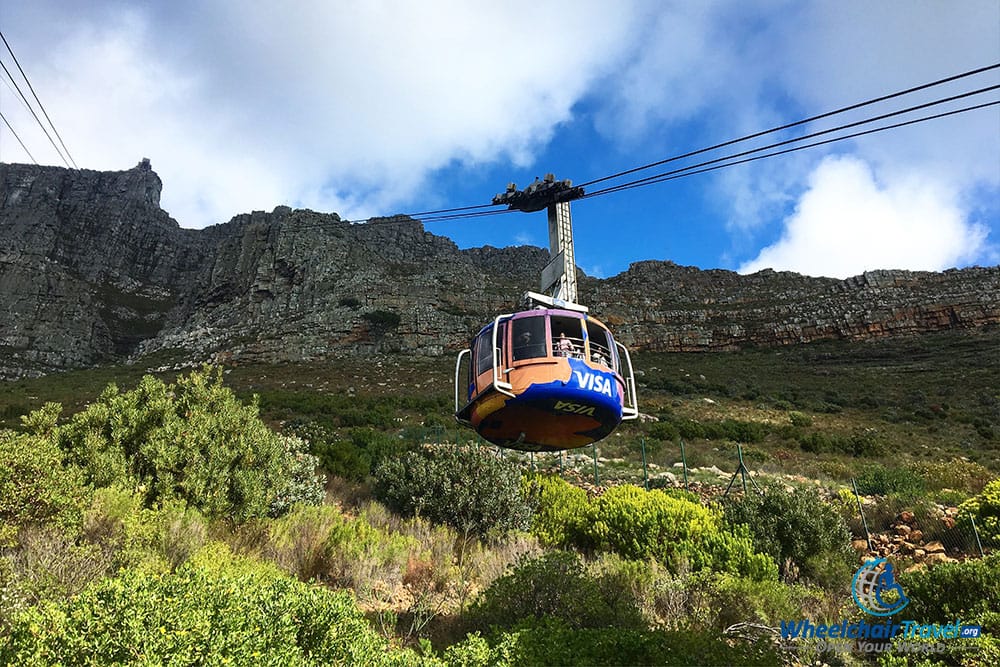
Wheelchair users have an opportunity to reach the mountaintop on the Table Mountain Aerial Cableway. At the top, you’ll touch the clouds (seriously!) while enjoying amazing views of the city and Atlantic coastline down below. Paved pathways criss-cross the top of the mountain, providing multiple perspectives of the region from high altitude.
I have shared more about accessibility in my blog post, Going to the Top of Table Mountain with a Wheelchair. If you have a chance to ride the cable car to the summit, don’t pass it up!
The Cape Wheel
Located at the center of the V&A Waterfront complex, the Cape Wheel takes riders to a height of 40 meters (~131 feet). Incredible views await with Table Mountain, Robben Island, the Cape Town Stadium and the Pearl Mountains all within sight.
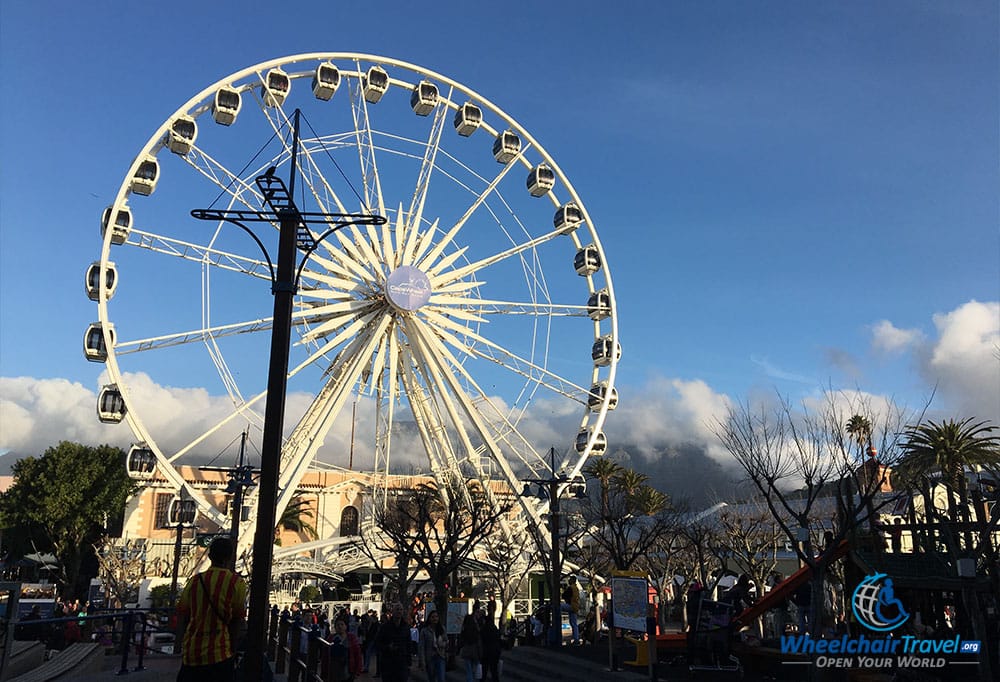
Unfortunately, due to a change in policy, wheelchairs can no longer be taken into the Cape Wheel gondolas. If you can stand or walk a short distance, you can sit inside the gondola and leave your wheelchair behind. Riders will make four revolutions in the course of a ride, which lasts a little over 20 minutes. Tickets cost 130 ZAR (~$9.50 USD) for adults and 60 ZAR for children.
For more information, visit www.capewheel.co.za.
Castle of Good Hope
Built between 1666 and 1679, the Castle of Good Hope is believed to be the oldest surviving building in all of South Africa. Although the castle was built as a military fortress, it was also home to a small community of people. The walls protected not only the military and armaments, but also a church, offices, residential quarters, a bakery and more.
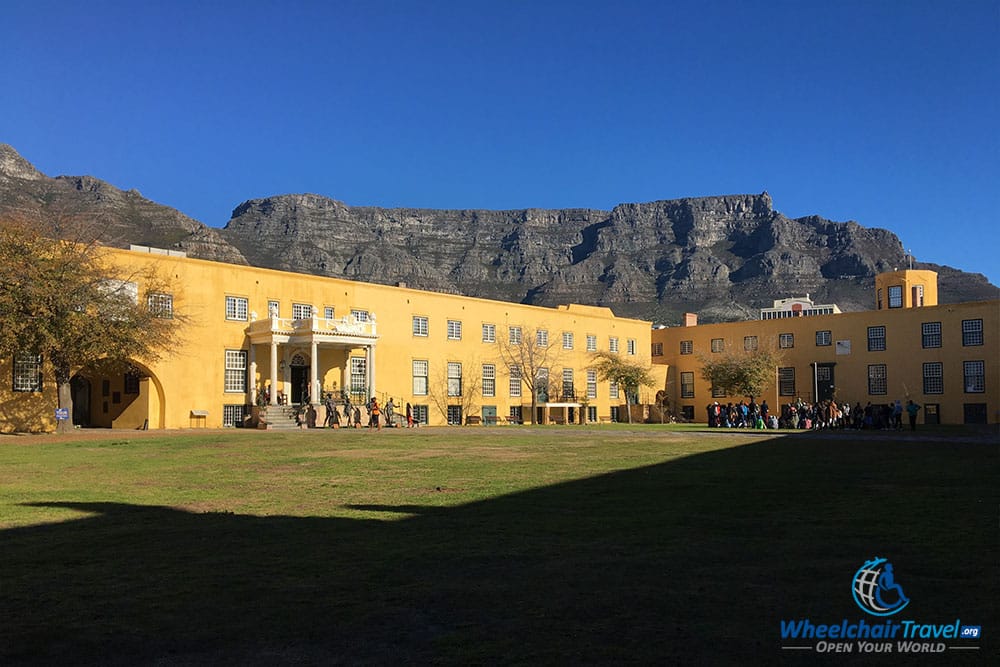
Following a restoration in 1986, the castle was opened to the public. Due to the age of the structure and in the interest of historical preservation, wheelchair accessibility was not included in the renovation plans. Although the interior courtyards are accessible, walkways are paved with cobblestones which make for an exceedingly difficult journey. Roll on the grass where possible! Most of the castle buildings inaccessible, including a Military Museum off the main courtyard. I was able to tour a very small (though impressive) African pottery and art collection, but getting to that section of the castle required a long roll on the cobblestone pathways. Surprisingly, the bathrooms and restaurant were wheelchair accessible.
When I visited the Castle of Good Hope, I was only asked to pay the admission fee for resident pensioners. Personally, I believe wheelchair users should be given a free pass due to the extremely limited accessibility. Current admission rates are 50 ZAR (~$3.67 USD) for adults and 25 ZAR for children and South African pensioners.
For more information, visit www.castleofgoodhope.co.za. A detailed history of the castle can be found here.
District Six Museum
The District Six Museum was opened in 1994 to tell the tragic history of the forced removals of residents in Cape Town. When the city’s sixth district was first established in 1867, its residents included freed slaves, laborers and immigrants. But at the turn of the 20th century, a slow process of forced removals began. This practice became official in 1966, when the district was declared a white area under the Group Areas Act of 1950. All non-white residents were forced from their homes and expelled.

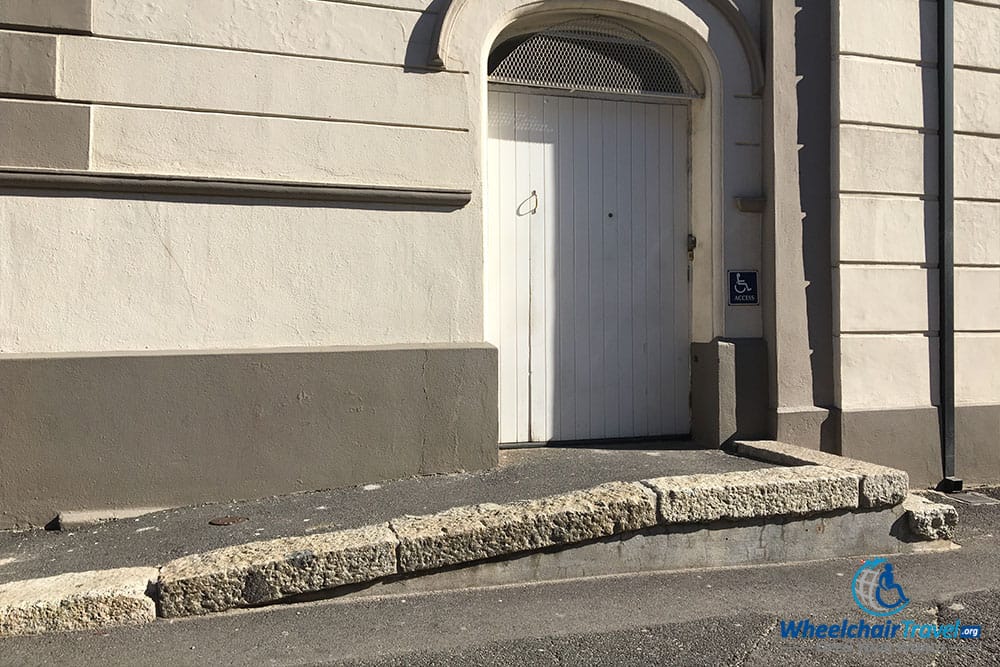
I arrived at the museum very much looking forward to learning more about the forced removal. Unfortunately, the museum is closed on Sundays. I wasn’t able to go inside to assess the accessibility, but I did find a wheelchair accessible entrance (with a ramp) on the side of the museum building. The sidewalk surrounding the museum did not have a curb cut, but the curb was low enough for a manual wheelchair to clear it with some effort. My power wheelchair was able to hop the curb as well.
For more information, visit the District Six Museum website at www.districtsixmuseum.co.za. If you have visited this museum and can provide information on accessibility, please do so in the comments below.
Drive Around the Western Cape
With so much beautiful scenery and coastline to explore, Cape Town visitors need to take a drive around the Western Cape. You’ll have the most flexibility with a private car, but I rode around the Cape aboard a wheelchair accessible Hop-on Hop-off sightseeing bus.
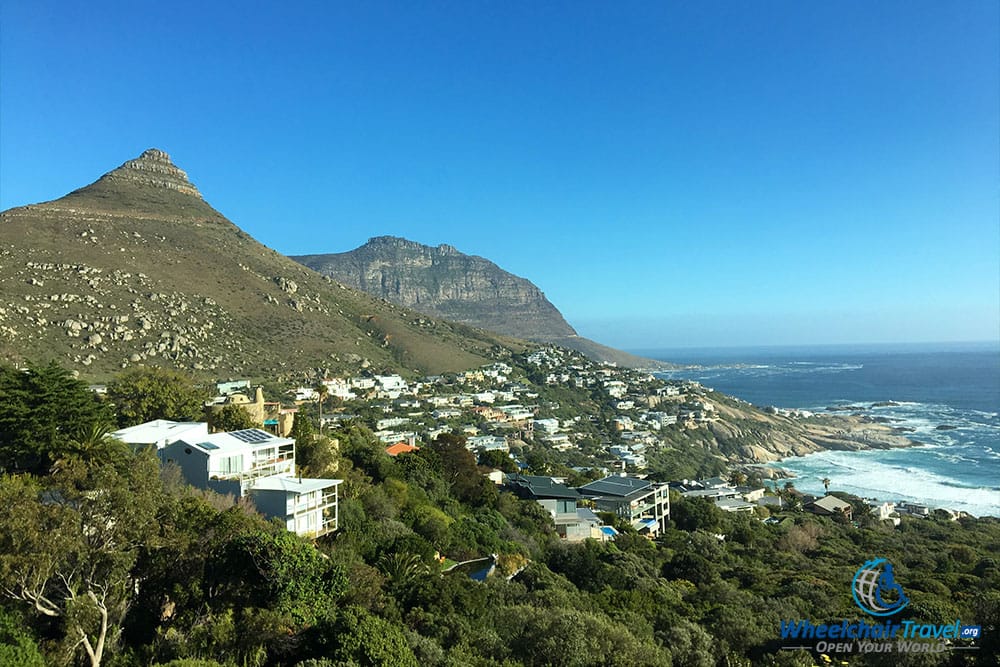
City-Sightseeing’s blue line bus (Mini Peninsula Tour) is the best route for coastal sightseeing. Key coastal stops include Hout Bay, Camps Bay and Green Point. You can hop-off at any stop you like to roll along the beach (on Beach Road), go shopping or eat at any of the restaurants. From the bus, you’ll have a fantastic view of the coastline and the 12 Apostles mountain range. You’ll also see amazing beachfront homes that are owned by the world’s wealthiest businesspeople and celebrities.
Green Point Park
If you’re like me—you don’t care for the beach but love the outdoors—Green Point Park is a great place to visit. Only a block from the beach, you’ll catch the ocean breeze, but you won’t have to deal with the sandy shore. Wheelchair accessible pathways wind through Green Point Park, and it’s only a short roll to the City-Sightseeing bus stop or the MyCiti bus stop.
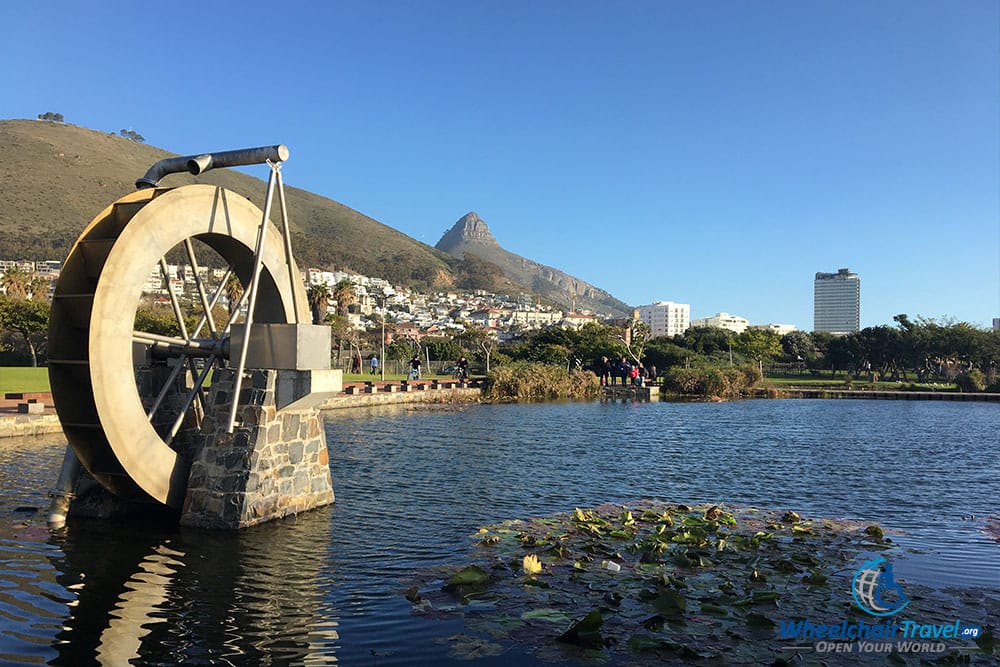
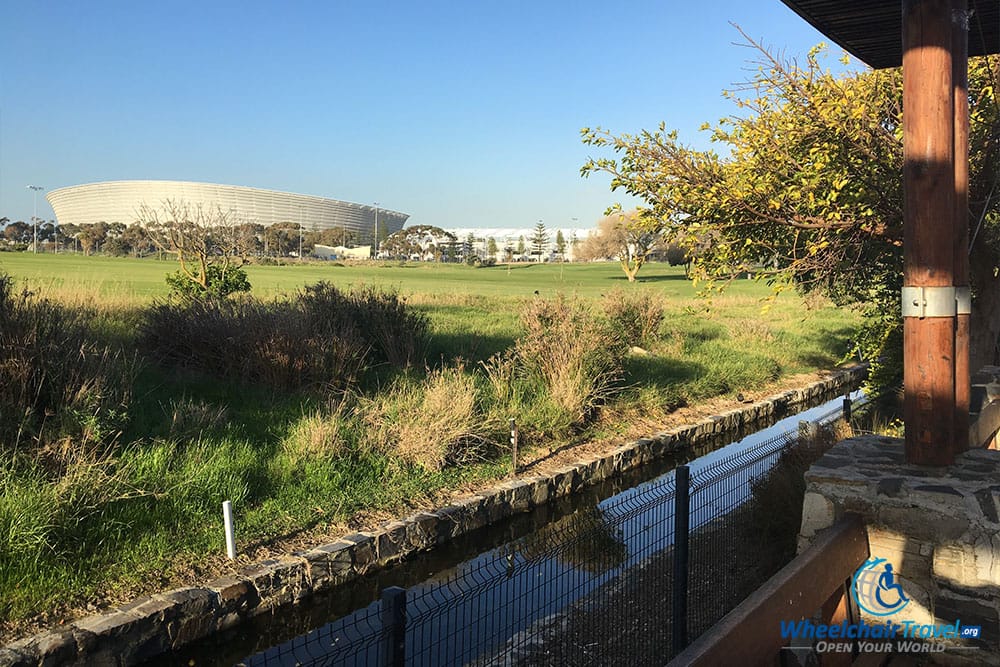
Green Point Park is at the foot of Signal Hill, with Lion’s Head poking out in the distance. A golf course runs alongside the park, and Cape Town Stadium (built for the 2010 FIFA World Cup) is also within view. In the park, you’ll find people reading a book, having a picnic or enjoying an afternoon picnic on the grass or under the shade of a tree. If not need a bathroom break, a wheelchair accessible toilet is right next to a small cafe/snack bar. Nothing too amazing here, but it is a nice park in a beautiful spot.
Kirstenbosch National Botanical Gardens
Founded in 1913 to cultivate and preserve flora unique to the region, Kirstenbosch Botanical Garden covers approximately 1,300 acres at the foot of Table Mountain.
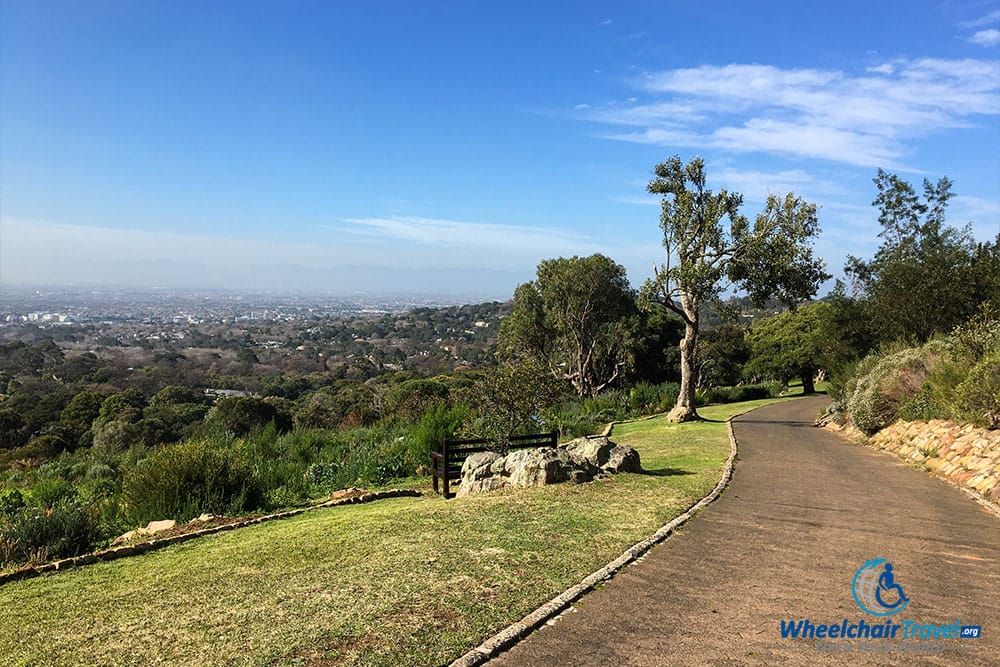
Pathways connect to most points within the gardens, but there are significant changes in elevation as seen in the photo above. Curbs along pathways are minimal—usually 1 to 2 inches in height—and visitors frequently walk on the grass to get a closer view of the flora. The path pictured above is near the garden’s higher elevation. Many pathways are steep, but others are relatively flat. Power wheelchairs can manage the climbs, but manual wheelchair users would struggle.
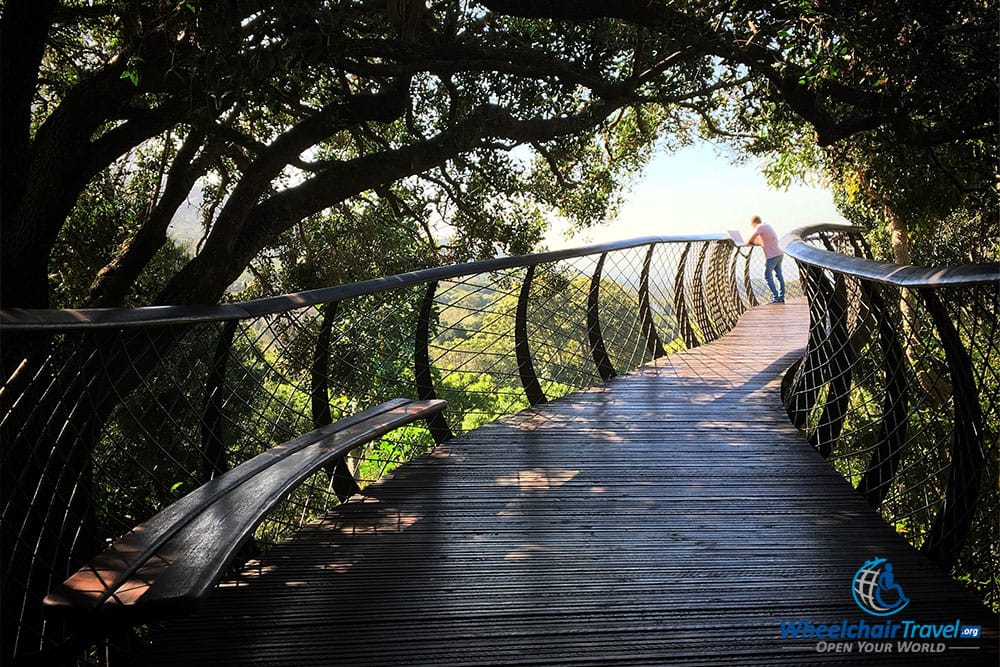
The most popular attraction at Kirstenbosch is the Boomslang Canopy Bridge, which weaves through a tree canopy and reaches out high over a valley within the park. The views are incredible. The bridge is wheelchair accessible, but the dirt path down to it is somewhat steep. I managed OK without assistance, but I do have a power wheelchair.
Other features of the park include a gift shop and three cafes/restaurants. After I finished exploring the gardens, I enjoyed a late lunch at the Kirstenbosch Tea Room. It was fantastic!
Admission to the gardens is 65 ZAR (~$4.75 USD) for adults and 15 ZAR for children. Although the city bus does not stop nearby, Kirstenbosch is a stop on the City-Sightseeing blue line bus. For more information or to plan your day at the gardens, visit the South African National Biodiversity Institute’s website at www.sanbi.org.
Robben Island
You’ve heard of Nelson Mandela, right? He was awarded the Nobel Peace Prize in 1993 and served as the President of South Africa from 1994 to 1999. Stopping there would not do him justice, though. His contributions to South Africa and to the world were much greater than any prize or title could suggest.
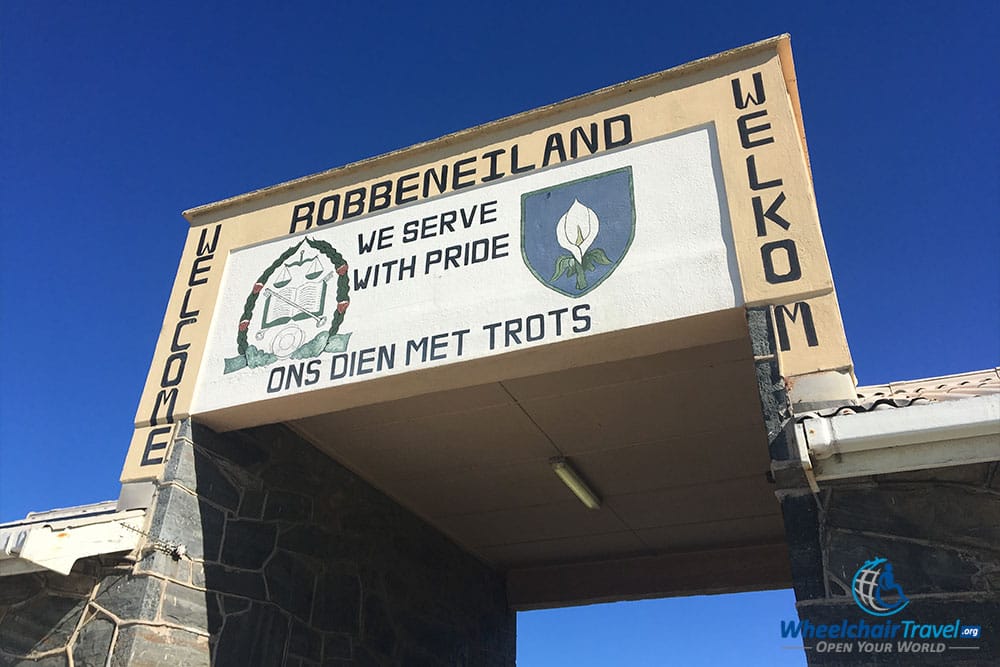
Robin Island, located 10 kilometers off the coast of Cape Town, is a place that provides a window to the past. It was here, in a small jail cell, that Nelson Mandela spent 18 years of his life. Imprisoned for fighting against apartheid, Mandela took a Long Walk to Freedom (the title of his autobiography).
The island prison was created to sustain an unacceptable status quo – the oppressive racial hierarchy known as apartheid. Visitors come face-to-face with this history as they interact with former prisoners who now freely serve as tour guides.

Tours depart daily from The Nelson Mandela Gateway to Robben Island Museum at the V&A Waterfront and last for approximately 3.5 hours. A boat ride of 30-45 minutes in each direction is wheelchair accessible, as is the bus and walking tour on the island. Tickets for adults cost 340 ZAR ($26 USD) and include round-trip ferry transportation, a bus tour and walking tour of the prison where Nelson Mandela was held.
Be sure to read about my experience visiting Robben Island with a wheelchair in my blog post, Following Mandela: A Tour of Robben Island.
Signal Hill
Formerly used as the spot for communicating with ships before the advent of radio, Signal Hill remains an important spot on the Cape. Also known as the Lion’s Rump, seen together with Lion’s Head it appears to be a sphinx-like natural phenomenon. Today it is a fantastic lookout point, as the ocean, Lion’s Head, Table Mountain and the city are all visible from the hilltop.
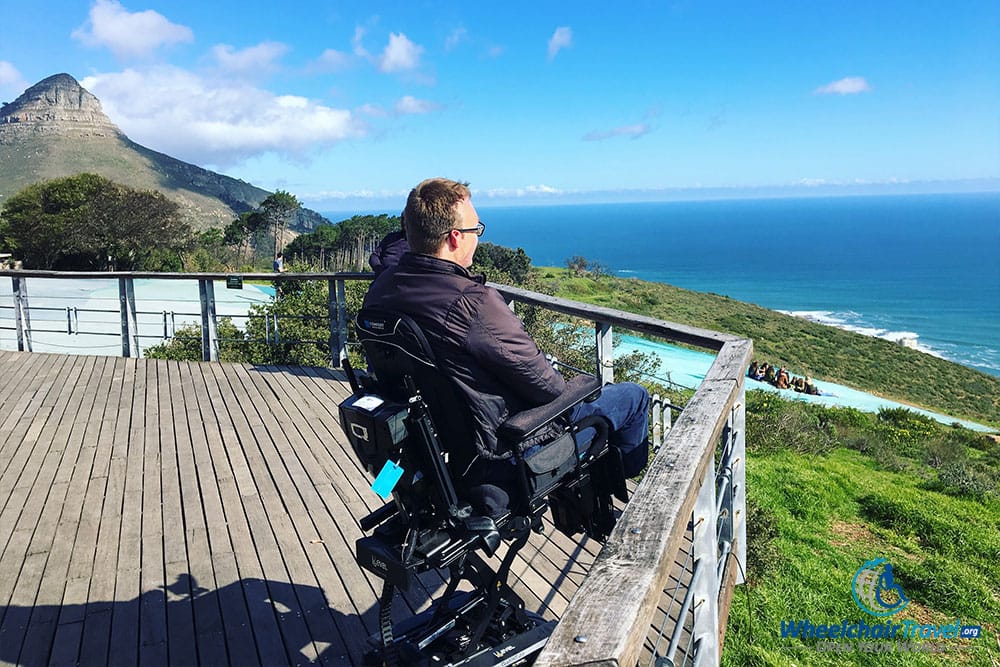
The photo above captured me looking out towards the ocean from the top of Signal Hill. The green covering—laid out like a rug down the hillside—is a launch area for paragliders. Next time I visit Cape Town, I definitely plan to launch!
No city or sightseeing buses travel to Signal Hill, so you’ll need to use a car or taxi to get to the top. Unless you plan to go paragliding, you won’t spend a lot of time on the hill—I only spent 15 minutes at the top.
Two Oceans Aquarium
The Two Oceans Aquarium, located on the V&A Waterfront, first opened its doors in 1995. The museum’s name alludes to the convergence of the Indian and Atlantic Oceans—where two oceans meet. The actual geographic point where this convergence occurs is at Cape Agulhas, which is 138 miles to the southeast of Cape Town (by car).

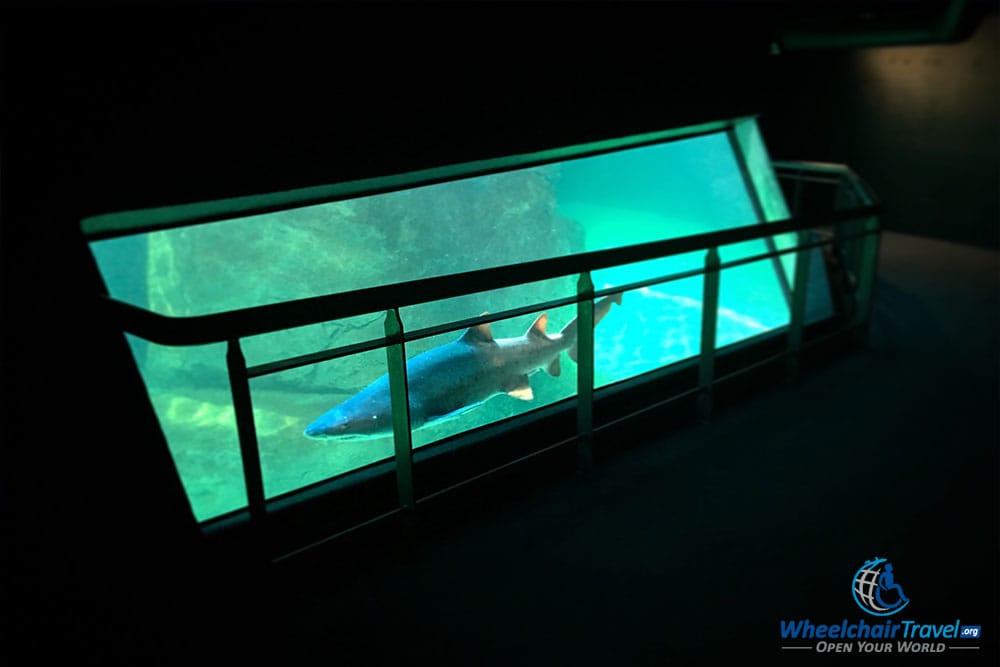
I’ve been to a lot of aquariums. But I keep going because they are incredible places to take children, and I know a lot my readers have kids. Two Oceans Aquarium is one of the better aquariums I have visited, though it is a touch on the small side. That said, there are many great opportunities to see, touch and come close to marine life. I especially enjoyed the very large tank filled with Ocellaris Clownfish, of Finding Nemo fame.
The various exhibits and galleries were easy to roll around in a wheelchair, and there is even a penguin exhibit on the basement level. A wheelchair accessible companion restroom is available. Tickets purchased at the aquarium are 165 Rand (~$12 USD) for adults. I was charged the South African pensioner rate of 120 Rand, most likely because of my clearly visible disability (and wheelchair). Tickets purchased online are discounted by 10%.
For more information, visit www.aquarium.co.za.
Wheelchair-Friendly Beaches
I spent time around Camps Bay Beach and also at Green Point, but I’m not a beachgoer. It being a brisk 50 degrees when I visited, I had no interest in going down to the water.
If you are interested in visiting the beaches of Cape Town, check out this article on accessibility at Boulders Beach from Melanie at Little Miss Turtle.



